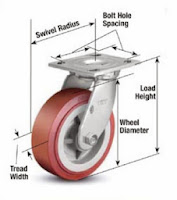Here are some important things to remember when choosing casters:
- Weight or Load Capacity - Before you decide on any caster based on material, diameter or attachment point, you have to determine the weight of what you’re trying to move. Each caster holds a maximum load capacity and this includes not only the object that you’re trying to move, but any cart or equipment weight that will also be the burden of the caster. Once you know the total weight of your load, you’ll be able to do divide that by the number of casters and wheels you’re using to find out the load capacity per wheel. Add more casters to heavy pieces to distribute the weight evenly and safely. Casters and wheels can fail and possibly injure you if not analyzed correctly for weight loads. Even when analyzed for proper load capacity, you’ll have to be cautious not to overload your casters. Try to move your load across an even surface at a steady, slow pace.
- Attachment - Two attachment strategies are available from most caster manufacturers. One type is better for movement whereas the other is better for larger, stable objects.
- Post/Stem casters use a long peg that fits directly into a machined orifice in the piece. A 2-inch chrome/gray rubber stem caster, for example, affixes to the object being moved to create a locking connection point. As you move around, the stem remains stable within the construction.
- Plate casters use screws to attach the fastener to the object's base.
- Wheel Type - Choose caster and wheel materials that match your strength and durability needs. As a cost saving tip, increasing the height and width of a caster and wheel will increase your load as long as you’re keeping your wheel materials consistent. Moving to a larger 10”x2” phenolic wheel from a smaller phenolic wheel will increase capacity, but moving to a 10”x2” Polyurethane wheel from a smaller phenolic wheel will not.
- Plastic is an inexpensive choice for lightweight applications since it is a softer material. For example, rolling a lightweight cart across a warehouse does not require a strong caster material.
- Select all steel wheels for heavy duty needs, such as moving heavy cargo loads on a cart. Phenolic wheels are also a stronger compound that may be beneficial in heavy duty moves.
- Office applications, where you need to protect the flooring from scuffs, require polyurethane or rubber casters. These soft materials keep the floor shining brightly, but they can’t handle the same heavy load capacity as a steel or phenolic wheel.
- Surfaces – In general, the larger the wheel diameter of your caster, the easier it roll across any surface. Anti-friction bearings will also help improve the smoothness of your ride. Of course, there are many different types of wheels and caster materials that are specially designed.
- If you have a slick floor surface, choose casters with specialized teeth. Typically applied to hard rubber materials, these locking teeth hold the wheels in place when you activate their mechanism.
- Wheels with soft rubber treads will help protect certain floors like softer tiles or hardwood floors commonly found in homes.
- If you need to increase load capacity across a softer floor, choose a Polyurethane tread.
- Regardless of your surface and wheel type, if you’re repetitive moving your load across the same path and surface, you will eventually see wear on the surface.
- Direction - Some of the objects you move need to be moved in a basic straight direction, including food carts. Other applications, such as electronic mobile cabinets, require precision movement with 360-degree casters. Swivel casters allow you to move the in almost any direction instantaneously. A 2-inch black/black poly stem caster is an elegant-looking wheel that blends in with black electronic cabinets for a professional appearance.
- Specialty Casters - You may have certain caster needs that are outside generic contours. For medical industries, look for anti-bacterial wheels to prevent germ spread throughout a building, such as on crash carts. Shock absorbent casters are also available for sensitive electronics, including medical instruments.


Whenever we get the chairs all you look first if the chair is comfortable or not and if it is the wheel chair. Then, we look at the wheel of the chair. So get the comfortable meeting room chairs from Burgess Furniture Ltd.
ReplyDeleteThis comment has been removed by the author.
ReplyDeleteThe dolly is a very specialized tool used to transport heavy items from one place to another. There are so many types of dolly such as crate dolly, box dolly, and 4 4 wheel dolly. You should choose the right dolly according to your needs.
ReplyDeleteI like the work which you have placed in this article. This data is significant and superb. I might want to thank you for sharing this article here. used office furniture dallas
ReplyDeleteCasino - FilmfileEurope
ReplyDeleteCasino. Free 토토 디비 큐어 벳 and open 24 토토사이트 가입 샤오미 hours a 토토사이트 해킹 샤오미 day, seven 바카라 검증 사이트 days a week. With the widest variety of games available to players from all over 야동 사이트 순위 the world, this is a